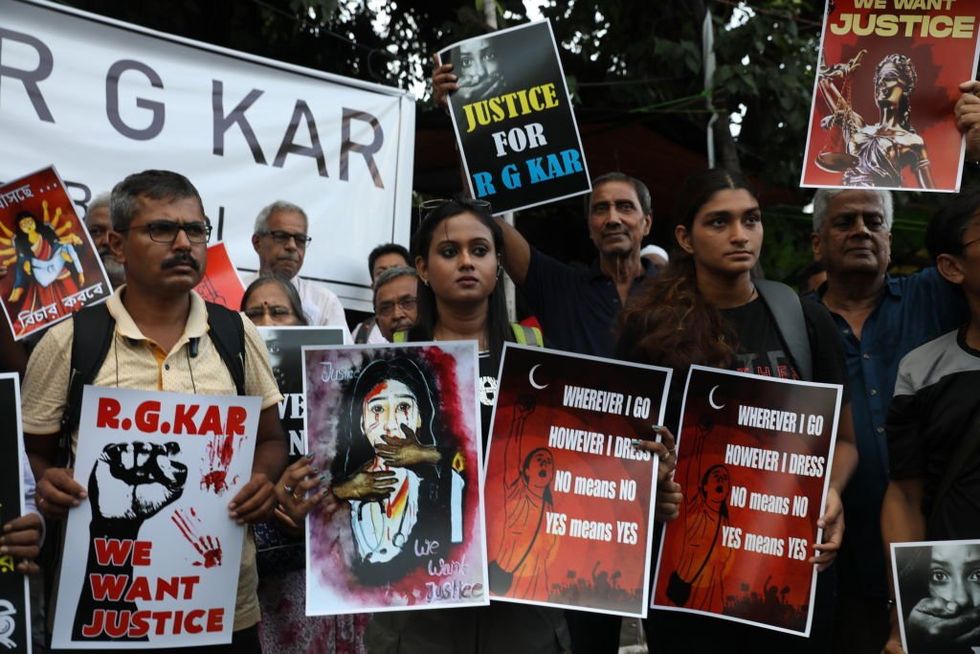Is India’s rape culture coming to America?
India is failing its women. An average of 90 rapes a day are reported in the country, a horrifying statistic that translates to almost four rapes every hour. And it's likely that the real numbers are far higher, as social stigma and mistrust of the legal system keep many rape victims from speaking out. This isn't woke hyperbole. The violence against women in India is systematic. It’s entrenched in its social fabric, perpetuated by institutions that protect the powerful while leaving victims helpless. In March, the gang rape of a Brazilian-Spanish tourist in the eastern state of Jharkhand sparked widespread outrage, yet again exposing how unsafe women are in India, even foreign visitors. The 28-year-old woman and her husband had paused for the night in the Dumki district during a months-long motorcycle tour through Asia. They thought they were stopping for some much-needed rest. Instead, they found horror, their lives forever changed. Shattered lives This tragic event is not an anomaly but part of a broader pattern of violence that women, both Indian and foreign, face within the country. Just recently, in the eastern state of Odisha, a woman was sexually assaulted by a group of cops — within the supposed sanctuary of a police station. When those sworn to uphold the law become the very perpetrators of unimaginable violence, it shows just how bad things are. The recent rape and murder of a trainee doctor at RG Kar Medical College and Hospital in Kolkata only deepens this shocking narrative. After a grueling 36-hour shift, the young woman went to a seminar room to take a nap. Her naked, brutalized body was found the following morning. Incredibly, college authorities initially judged her death a suicide; an autopsy soon revealed she had been raped and murdered. Once again, those responsible attempted to cover up the crime, protecting the institution rather than the victim. A familiar story In India, an incredibly corrupt country, it’s a tale all too familiar. Authorities attempt to obscure the truth, protect reputations, and downplay violence. When a crime as heinous as rape happens, the system scrambles — not to provide justice but to deny the scale of the problem. It’s a symptom of a deeply ingrained societal sickness in which women are conditioned to remain silent and institutions are designed to bury the evidence. Despite India’s image as a rapidly modernizing democracy, a primitive mindset prevails. To those who might dismiss this as narrow-minded xenophobia, consider that this is a nation where the caste system not only exists but reigns supreme. The lowest tier — the "untouchables" — experiences systemic discrimination and ostracism. In India, cows are treated with far more respect than these people. It doesn’t get much more primitive than that. Even in metropolitan cities, where progress is supposed to be the hallmark of modernity, women face the constant threat of harassment, assault, and abuse. The laws exist on paper, but in practice, justice is a distant dream for many victims. What is shocking isn't just the violence but the scale at which society tolerates it. In the West, feminist discourse finds itself detached from real danger, focusing on microaggressions and perceived slights. But in India, the threat to women from men is real. It manifests in blood, broken bones, and brutalized bodies. Exporting evil? This isn't just about local tragedies. Violence of this magnitude doesn't exist in a vacuum. Thanks to a steady flow of immigration, particularly to the U.K., Indians have remained at roughly 8% of the EU's total population over the last few decades. Britain has long struggled with Muslim gangs. However, a lesser-known but equally troubling problem has emerged with young Hindu thugs roaming the streets, contributing to growing unrest. These groups, often fueled by religious and ethnic tensions, have caused chaos in cities like Leicester and Birmingham. The rise of Hindu gangs underscores the deepening divisions and lawlessness in certain parts of England, Wales, and Scotland. Across the Atlantic, Canada has seen a massive rise in Indian immigrants, with numbers skyrocketing from 32,828 in 2013 to 139,715 in 2023, an increase of 326%. As more Indians migrate, the troubling patterns of violence against women appear to follow. Consider the case of Gurpreet Singh Gill, an Indian immigrant in his 40s who sexually assaulted a passenger in his taxi. His plea for leniency in a Canadian Federal Court highlighted the potential collateral damage to his family — his wife could lose their home, his daughter might have to leave private school and stop her dance lessons, and his son had been born just days before his crime. Yet in his rather embarrassing appeal for mercy, as noted in this report, Gill neglected to acknowledge the real victim: the intoxicated young woman he violated in the back of his cab. Then there’s the Indian Canadian who lured a young student t


India is failing its women.
An average of 90 rapes a day are reported in the country, a horrifying statistic that translates to almost four rapes every hour.
And it's likely that the real numbers are far higher, as social stigma and mistrust of the legal system keep many rape victims from speaking out.
This isn't woke hyperbole. The violence against women in India is systematic. It’s entrenched in its social fabric, perpetuated by institutions that protect the powerful while leaving victims helpless.
In March, the gang rape of a Brazilian-Spanish tourist in the eastern state of Jharkhand sparked widespread outrage, yet again exposing how unsafe women are in India, even foreign visitors. The 28-year-old woman and her husband had paused for the night in the Dumki district during a months-long motorcycle tour through Asia. They thought they were stopping for some much-needed rest. Instead, they found horror, their lives forever changed.
Shattered lives
This tragic event is not an anomaly but part of a broader pattern of violence that women, both Indian and foreign, face within the country. Just recently, in the eastern state of Odisha, a woman was sexually assaulted by a group of cops — within the supposed sanctuary of a police station. When those sworn to uphold the law become the very perpetrators of unimaginable violence, it shows just how bad things are.
The recent rape and murder of a trainee doctor at RG Kar Medical College and Hospital in Kolkata only deepens this shocking narrative. After a grueling 36-hour shift, the young woman went to a seminar room to take a nap. Her naked, brutalized body was found the following morning.
Incredibly, college authorities initially judged her death a suicide; an autopsy soon revealed she had been raped and murdered. Once again, those responsible attempted to cover up the crime, protecting the institution rather than the victim.
A familiar story
In India, an incredibly corrupt country, it’s a tale all too familiar. Authorities attempt to obscure the truth, protect reputations, and downplay violence. When a crime as heinous as rape happens, the system scrambles — not to provide justice but to deny the scale of the problem. It’s a symptom of a deeply ingrained societal sickness in which women are conditioned to remain silent and institutions are designed to bury the evidence.
Despite India’s image as a rapidly modernizing democracy, a primitive mindset prevails. To those who might dismiss this as narrow-minded xenophobia, consider that this is a nation where the caste system not only exists but reigns supreme. The lowest tier — the "untouchables" — experiences systemic discrimination and ostracism. In India, cows are treated with far more respect than these people. It doesn’t get much more primitive than that.
Even in metropolitan cities, where progress is supposed to be the hallmark of modernity, women face the constant threat of harassment, assault, and abuse. The laws exist on paper, but in practice, justice is a distant dream for many victims.
What is shocking isn't just the violence but the scale at which society tolerates it. In the West, feminist discourse finds itself detached from real danger, focusing on microaggressions and perceived slights. But in India, the threat to women from men is real. It manifests in blood, broken bones, and brutalized bodies.
Exporting evil?
This isn't just about local tragedies. Violence of this magnitude doesn't exist in a vacuum. Thanks to a steady flow of immigration, particularly to the U.K., Indians have remained at roughly 8% of the EU's total population over the last few decades.
Britain has long struggled with Muslim gangs. However, a lesser-known but equally troubling problem has emerged with young Hindu thugs roaming the streets, contributing to growing unrest. These groups, often fueled by religious and ethnic tensions, have caused chaos in cities like Leicester and Birmingham. The rise of Hindu gangs underscores the deepening divisions and lawlessness in certain parts of England, Wales, and Scotland.
Across the Atlantic, Canada has seen a massive rise in Indian immigrants, with numbers skyrocketing from 32,828 in 2013 to 139,715 in 2023, an increase of 326%. As more Indians migrate, the troubling patterns of violence against women appear to follow.
Consider the case of Gurpreet Singh Gill, an Indian immigrant in his 40s who sexually assaulted a passenger in his taxi. His plea for leniency in a Canadian Federal Court highlighted the potential collateral damage to his family — his wife could lose their home, his daughter might have to leave private school and stop her dance lessons, and his son had been born just days before his crime.
Yet in his rather embarrassing appeal for mercy, as noted in this report, Gill neglected to acknowledge the real victim: the intoxicated young woman he violated in the back of his cab. Then there’s the Indian Canadian who lured a young student to a Toronto hotel room and sexually assaulted her. In July, an Indian man was arrested following a mass groping incident at a water park in Moncton, New Brunswick.
Alarmingly, as Indian immigration to Canada rises, recent reports show an increasing trend of Indian migrants illegally crossing into the U.S., favoring this route over the more-discussed southern border. This migration, driven by hopes of better opportunities and laughable deportation laws, brings with it a troubling danger — a pattern of barbaric behavior that is becoming harder to ignore.
Originally Published at Daily Wire, World Net Daily, or The Blaze
What's Your Reaction?
































































































